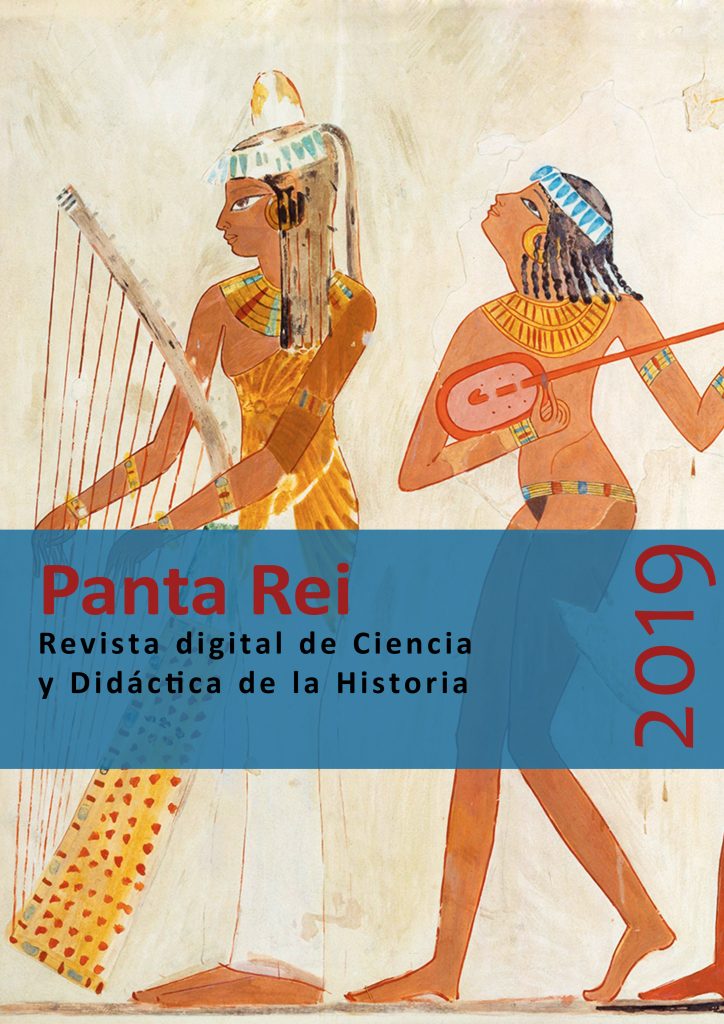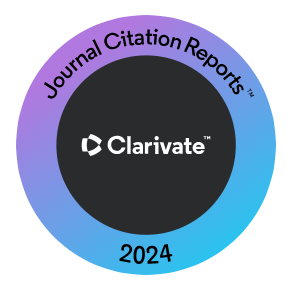La representación de la danza dentro de las escenas de banquete de las tumbas tebanas privadas de la XVIII dinastía egipcia
Resumen
El presente artículo es fruto de una investigación sobre la representación de la danza en las tumbas tebanas privadas del Reino Nuevo (1550-1070 a.C.). En él se pretende poner en contexto la representación de la danza dentro de las conocidas escenas de banquete de la XVIII dinastía (1550-1295 a.C.), así como analizar, mediante el estudio de todas las escenas encontradas, sus características principales y su simbología. Por último, se intentará explicar su posible interpretación, basada en el contexto en el que aparecen, y las convenciones utilizadas para su representación. Por lo tanto, se resaltarán los elementos comunes de estas escenas (ubicación, iconografía…) que son los que nos ayudan a entender su significado e importancia. Se trata de un tema relevante, ya que estas escenas de banquete en las que aparecen bailarinas estaban cargadas de contenido simbólico y estético, y servían de nexo entre el difunto y los visitantes de la tumba. Tenían así, por lo tanto, una gran importancia para el pensamiento religioso egipcio, pues ayudaban a la supervivencia del difunto en el Más Allá.
Descargas
-
Resumen880
-
PDF382
-
EPUB92
Citas
Aldred, C. (1951). New Kingdom art in ancient Egypt during the eighteenth dynasty. Londres: A. Tiranti.
Anderson, R. D. (1995). Music and Dance in Pharaonic Egypt. En J. M. Sasson, Civilizations of the Ancient near East, vol. VI (pp. 2555-2568). Nueva York: Scribner’s.
Bleiberg, E. (2005) Dance. En E. Bleiberg (ed.), Arts and Humanities through the Eras. Ancient Egypt 2657-332 B.C.E. (pp. 64-85). Detroit: Thomson Gale.
Bolshakov, A. O. (1991). The Moment of the Establishment of the Tomb-Cult in Ancient Egypt. Altorientalische Forschungen, 18, 204-218.
Bosse-Griffiths, K. (1983). The Fruit of the Mandrake. En M. Görg (ed.), Fontes Atque Pontes, 5 (pp. 62-74). Wiesbaden: Harrasowitz.
Bouriant, U. (1889). Tombeau De Harmhabi. Mémoires publiés par les membres de la mission archéologie française au Caire, 5(2), 413-434.
Brack, A. y Brack, A. (1980). Das Grab des Haremheb: Theben Nr. 78. Mainz am Rein: Philipp von Zabern.
Brunner-Traut, E. (1958). Der Tanz im Alten Ägypten. Nach bildlichen und inschriftlichen Zeugnissen. Glückstadt, Hamburgo, Nueva York: J. J. Augustin.
Bryan, B. M. (2001). Painting techniques and artisan organization in the Tomb of Suemniwet, Theban Tomb 92. En W. V. Davies (ed.), Colour and Painting in Ancient Egypt (pp. 63-72). Londres: British Museum Press.
Bryan, B. M. (2009). Memory and knowledge in Egyptian tomb painting. En E. Cropper (ed.), Dialogues in Art History, from Mesopotamian to Modern: Readings for a new century (pp. 19-39). Washington: National Gallery of Art.
Bryan, B. M. (2010). La XVIII Dinastía antes del Período Amárnico (c. 1550-1352 a.C.). En I. Shaw, Historia del antiguo Egipto (pp. 287-357). Madrid: La esfera de los libros.
Bryan, B. M. (2015). “Just Say ‘No’”-Iconography, Context, and Meaning of a Gesture. En A. Oppenheim y O. Goelet (eds.), The Art and Culture of Ancient Egypt: Studies in Honor of Dorothea Arnold, Bulletin of the Egyptological Seminar (BES) (vol. 19) (pp. 187-198). Nueva York: Egyptological Seminar of New York.
Calcoen, B. (2012). TT176: The Tomb Chapel of Userhat. Londres: Golden House Publications.
Counsell, D. J. (2008). Intoxicants in Ancient Egypt? Opium, nymphea, coca, and tobacco. En R. David (ed.), Egyptian mummies and modern science (pp. 195-215). Cambridge: Cambridge University Press.
Cherpion, N. (1994). Le “cône” d’onguent, gage de survie. Bulletin de l’Institut Français d’Archéologie Orientale (BIFAO), 94, 79-106.
Daumas, F. (1977). Hathor, Lexikon der Ägyptologie (LÄ), II, col. 1024-1033.
Davies, N. de G. (1963). Scenes from Some Theban Tombs (Nos. 38, 66, 162, with Excerpts from 81). Oxford: Griffith Institute.
Davies, N. de G. y Gardiner, A. H. (1915). The tomb of Amenemhet (no. 82). Oxford: Oxford University Press.
Davies, N. de G. (1917). The tomb of Nakht at Thebes. Nueva York: Metropolitan Museum of Art.
Davies, N. de G. (1933). The tomb of Nefer-hotep at Thebes. Nueva York: Metropolitan Museum of Art.
Davies, N. de G. (1935). Paintings from the Tomb of Rekh-mi-Re’ at Thebes. Nueva York: Metropolitan Museum of Art.
Davies, N. de G. (1943). The Tomb of Rekh-mi-Re’ at Thebes. Nueva York: Metropolitan Museum of Art.
Davies, N. de G. (1923). The Tombs of Two Officials of Tuthmosis the Fourth (nos. 75 and 90). Londres: Egypt Exploration Society.
Den Doncker, A. (2017). Identifying-Copies in the Private Theban Necropolis. Tradition as Reception under the Influence of Self-Fashioning Processes. En T. Gillen (ed.), (Re)productive Traditions in Ancient Egypt, Universidad de Lieja, 6-8 de Febrero de 2013 (pp. 333-370). Lieja: Presses Universitaires de Liège.
Dodson, A. e Ikram, S. (2008). The tomb in Ancient Egypt: royal and private sepulchres from the early dynastic period to the Romans. Londres: Thames & Hudson.
Drioton, E. (1948). La danse dans l’ancienne Égypte. La Femme Nouvelle, 24-32.
Duemichen, J. (1869).Historische Inschriften Altägyptischer Denkmäler. Leipzig: J. C. Hinrichs.
Emboden, W. A. (1978). The sacred narcotic lily of the Nile: Nymphaea caerulea. Economic Botany, 32, 395-407.
Emboden, W. A. (1981). Transcultural use of narcotic water lilies in ancient Egyptian and Maya drug ritual. Journal of Ethnopharmacology, 3, 39-83.
Fakhry, A. (1943). Tomb of Paser (nº 367 at Thebes). Annales du service des antiquités de l’Égypte, 43, 389-414.
Foucart, G. (1924). La Belle Fête de la Vallée. Bulletin de l’Institut Français d’Archéologie Orientale, 24, 1-209.
Gauthier, H. (1908). Rapport sur une campagne de fouilles à Drah Abou’l Neggah en 1906. Bulletin de l’Institut Français d’Archéologie Orientale, 6, 163-171.
Graves-Brown, C. (2010). Dancing for Hathor: women in ancient Egypt. Londres: Bloomsbury Publishing.
Green, L. (2001). Toiletries and cosmetics. En D. B. Redford (ed.), The Oxford Encyclopedia of Ancient Egypt, vol. 3. Oxford: Oxford University Press.
Guksch, H. (1995). Die Gräber des Nacht-Min und des Men-cheper-Ra-seneb, Theben Nr. 87 und 79. Mainz: Philipp von Zabern.
Harer, W. B. (1984). Nymphaea: Sacred Narcotic Lotus of Ancient Egypt? Journal of the Society for the Study of Egyptian Antiquities, 14, 100-102.
Harer, W. B. (1985). Pharmacological and biological properties of the Egyptian lotus. Journal of the American Research Center in Egypt (JARCE), 22, 49-54.
Hartwig, M. K. (2004). Tomb painting and identity in ancient Thebes, 1419-1372 BCE. Turnhout: Brepols.
Harrington, N. (2012). Living with the dead: Ancestor worship and mortuary ritual in Ancient Egypt. Oxford: Oxbow Books.
Harrington, N. (2014). The Eighteenth Dynasty Egyptian banquet: ideals and realities. En Draycott, C. (ed.), Dining and death. Interdisciplinary perspectives on the “funerary banquet” in ancient art, burial and belief. Leuven: Peeters.
Ikram, S. (2001). Banquets. En D. B. Redford (ed.), The Oxford Encyclopedia of Ancient Egypt (vol. 1). Oxford: Oxford University Press.
Jiménez, Á. (2016). Development and Landscape of the Sacred Space at Dra Abu el-Naga: A case study within the Theban Necropolis (Tesis doctoral inédita). University of Liverpool.
Kampp-Seyfried, F. (2003). The Theban necropolis: an overview of topography and tomb development from the Middle Kingdom to the Ramesside period. En N. Strudwick y J. H. Taylor (eds.), The Theban Necropolis: past, present and future (pp. 2-10). Londres: The British Museum Press.
Kroeter, C. (2009). The sensual banquet scene: sex and senses in Eighteenth Dynasty Theban Tomb Paintings. North Street Review: Arts and visual culture, 13, 47-56.
Laboury, D. (1997). Une relecture de la tombe de Nakht (TT52, Cheikh Abd el-Gourna). En R. Tefnin (ed.), La Peinture Égyptienne Ancienne: Un monde de signes à préserver, Actes de colloque international de Bruxelles (pp. 49-81). Bruselas: Fondation Égyptologique Reine Élisabeth.
Laboury, D. (2017). Tradition and Creativity. Toward a Study of Intericonicity in Ancient Egyptian Art. En T. Gillen (ed.), (Re)productive Traditions in Ancient Egypt (pp. 229-258). Lieja: Presses Universitaires de Liège.
Lexová, I. (1935). Ancient Egyptian Dances. Praga: Instituto Oriental.
Manniche, L. (1987). City of the Dead: Thebes in Egypt. Londres: British Museum Publications.
Manniche, L. (1988). Lost Tombs: A Study of Certain Eighteenth Dynasty Monuments in the Theban Necropolis. Londres: KPI.
Manniche, L. (1988b). The Wall Decoration of Three Theban Tombs (TT 77, 175, and 249). Copenhage: Museum Tusculanum Press.
Manniche, L. (1991). Music and Musicians in Ancient Egypt. Londres: British Museum Press.
Manniche, L. (1997). El arte egipcio. Madrid: Alianza Forma.
Manniche, L. (1997b). Reflections on the banquet scene. En R. Tefnin (ed.), La Peinture Égyptienne Ancienne: Un monde de signes à préserver, Actes de colloque international de Bruxelles (pp. 29-36). Bruselas: Fondation Égyptologique Reine Élisabeth.
Manniche, L. (1999). Sacred Luxuries: Fragrance, Aromatherapy, and Cosmetics in Ancient Egypt. Nueva York: Cornell University Press.
Manniche, L. (2003). The so-called scenes of daily life in the private tombs of the Eighteenth Dynasty: an overview. En N. Strudwick y J. H. Taylor (eds.), The Theban Necropolis: past, present and future (pp. 42-45). Londres: British Museum Publications Limited.
Manzi, L. M. y Pereyra, M. V. (2014). El banquete funerario y la Bella Fiesta del Valle en Tebas occidental. NEARCO. Revista Eletrônica de Antiguidade, 1, 238-259.
Maspero, G. (1894). Tombeau de Nakhti. Mémoires publiés par les membres de la mission archéologie française au Caire, 5, 469-485.
Mekhitarian, A. (1957). Un peintre thébain de la XVIIIe dynastie. Mitteilungen des Deutschen Archäologischen Instituts, Abteilung Kairo, 15, 186-192.
Meyer-Dietrich, E. (2009). Dance. En W. Wendrich et alii (eds.), UCLA Encyclopedia of Egyptology. Los Ángeles, CA: University of California.
Morgan, L. (2015). Why is no one eating? The iconography of feasting in the ancient world. Journal of Ancient Egyptian Interconnections, 7(3), 49-64.
Naguib, S. A. (1991). The Beautiful Feast of the Valley. En R. Skarsten, E. J. Kleppe y R. B. Finnestad (eds.), Understanding and History in Arts and Sciences, Acta Humaniora Universitatis Bergensis (pp. 21-32). Oslo: Solum.
Navrátilová, H. (2010). Graffiti spaces. En L. Bareš et alii (eds.), Egypt in transition: social and religious development of Egypt in the first millennium BCE: Proceedings of an International Conference, Praga, 1-4 de Septiembre de 2009 (pp. 305-332). Praga: Czech Institute of Egyptology, Faculty of Arts, Charles University in Prague.
Padgham, J. (2012). A new interpretation of the cone on the head in New Kingdom Egyptian tomb scenes. Oxford: Archaeopress.
Pirelli, R. (2007). Les répertoires de scènes des tombeaux privés de la 18ème dynastie et les scènes de banquet: présentation d’une étude. En J.-C. Goyon y C. Cardin (eds.), Proceedings of the Ninth International Congress of Egyptologists: Grenoble, 6-12 septembre 2004 (pp. 1519-1525). Leuven: Peeters.
Porter, B. y Moss, R. L. B. (1970). Topographical bibliography of ancient Egyptian hieroglyphic texts, reliefs and paintings. Oxford: Griffith Institute, Ashmolean Museum.
Robins, G. (1996). Dress, Undress, and the Representation of Fertility and Potency in New Kingdom Egyptian Art. En N. B. Kampen et alii, Sexuality in ancient art. Near East, Egypt, Greece, and Italy (pp. 27-40). Cambridge: Cambridge University Press.
Schenkel, W. (1975). Die Gräber des PA-Tnf-j und eines Unbekannten in der Thebanischen Nekropole (Nr. 128 und Nr. 129). Mitteilungen des Deutschen Archäologischen Instituts, Abteilung Kairo, 31, 127-158.
Schiaparelli, E. (2007). La tomba intatta dell’architetto Kha nella necropoli di Tebe. Turín: Adartep.
Schott, S. (1953). Das schöne Fest vom Wüstentale: Festbräuche einer Totenstadt. Wiesbaden: Akademie der Wissenschaften und der Literatur, F. Steiner.
Seco, M. (1997). El niño en las pinturas de las tumbas tebanas de la XVIII dinastía. Sevilla: Kolaios.
Seidel, M. (1996). The Necropolis of Western Thebes to the End of the New Kingdom. En A. G. Shedid y M. Seidel, The tomb of Nakht: The art and history of an eighteenth dynasty official’s tomb at Western Thebes (pp. 9-11). Mainz am Rhein: Philipp von Zabern.
Shedid, A. G. (1988). Stil der Grabmalereien in der Zeit Amenophis’ II: Untersucht an den Thebanischen Gräbern Nr 104 und 80. Mainz am Rhein: Philipp von Zabern.
Shedid, A. G. y Seidel, M. (1996). The tomb of Nakht: The art and history of an eighteenth dynasty official’s tomb at Western Thebes. Mainz am Rhein: Philipp von Zabern.
Smith, W. S. (2009). Arte y arquitectura del antiguo Egipto. Madrid: Cátedra.
Spalinger, A. J. (2001). Festivals. En D. B. Redford (ed.), The Oxford Encyclopedia of Ancient Egypt, vol. 1. Oxford: Oxford University Press.
Strudwick, N. (1996). The Tombs of Amenhotep, Khnummose, and Amenmose at Thebes (Nos. 294, 253, and 254). Oxford: Griffith Institute.
Strudwick, N. (2003). The tomb of Amenemopet called Tjanefer at Thebes (TT 297). Abhandlungen des Deutschen Archäologischen Instituts Kairo. Berlín: Achet.
Szpakowska, K. (2003). Altered states: an inquiry into the possible use of narcotics or alcohol to induce dreams in Pharaonic Egypt. En A. K. Eyma y C. J. Bennett (eds.), A Delta-man in Yebu (pp. 225-237). Florida: Universal-Publishers.
Teeter, E. (2011). Religion and ritual in ancient Egypt. Nueva York: Cambridge University Press.
Van Dijk, J. (2010). El periodo amárnico y el final del Reino Nuevo. En I. Shaw, Historia del antiguo Egipto (pp. 359-410). Madrid: La esfera de los libros.
Vandier, J. (1964). Manuel d’archéologie égyptienne. Tome IV: Bas-reliefs et peintures. Scènes de la vie quotidienne. París: Auguste et J. Picard.
Vandier d’Abbadie, J. (1939). Deux tombes de Deir el-Medineh. Mémoires publiés par les membres de l’Institut français d’archéologie orientale, 73, 1-18.
Vischak, D. (2001). Hathor. En D. B. Redford (ed.), The Oxford Encyclopedia of Ancient Egypt. Oxford: Oxford University Press.
Valdesogo, M. R. (2005). El cabello en el ritual funerario del Antiguo Egipto a partir de los Textos de los Sarcófagos y de la evidencia iconográfica. Barcelona: Aula Aegyptiaca.
Virey, P. (1889). Le Tombeau de Rekhmare, Préfet de Thèbes sous la XVIIIe Dynastie. Mémoires publiés par les membres de la mission archéologie française au Caire. París: Ernest Leroux.
Virey, P. (1891). Tombeau de Menkheper. Mémoires publiés par les membres de la mission archéologie française au Caire, 5, 322-336.
Vivas, I. (2014). Identidad religiosa e identidad social: innovaciones en el programa decorativo de las tumbas tebanas privadas de la XVIII Dinastía. En S. Acerbi (ed.), Actas del X Congreso de la Sociedad Española de Ciencias de las Religiones (pp. 21-34). Santander: Universidad de Cantabria.
Wild, H. (1963). Les danses sacrées de l’Égypte ancienne. París: Tire a Part.
Wilkinson, A. (1998). The Garden in Ancient Egypt. Londres: Rubicon Press.
Derechos de autor 2019 Miriam Bueno Guardia

Esta obra está bajo una licencia internacional Creative Commons Atribución-CompartirIgual 4.0.
Todos los contenidos publicados en nuestra revista están sujetos a una licencia Atribución 4.0 Internacional (CC BY-SA 4.0) de Creative Commons. Usted es libre de compartir (copiar y redistribuir el material en cualquier medio o formato) y adaptar (remezclar, transformar y crear a partir del material para cualquier finalidad, incluso comercial), bajo los siguientes términos:
Reconocimiento: Debe reconocer adecuadamente la autoría, proporcionar un enlace a la licencia e indicar si se han realizado cambios. Puede hacerlo de cualquier manera razonable, pero no de una manera que sugiera que tiene el apoyo del licenciador o lo recibe por el uso que hace.
CompartirIgual: Si remezcla, transforma o crea a partir del material, deberá difundir sus contribuciones bajo la misma licencia que el original.
El texto completo de la licencia se puede consultar en: Licencia Creative Commons













